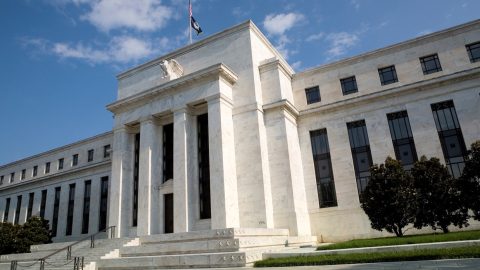In the year to date, we have seen numerous negative developments: interest and inflation worries in the USA, fears of an escalating trade conflict between the USA and the rest of the world, and a loss of trust in Italy and some emerging economies. And finally, the concerns about a possible recession (in the medium term), a hard Brexit, and financial market stability – ten years after Lehman – have also increased.
This environment has left (negative) traces on the performance of many asset classes. With only a few asset classes – especially US cash, US corporate bonds with low ratings, and US equities earning positive returns. At the same time, real global economic growth has remained strong: at about 3%, it is above the value that can be sustainably expected, i.e. above potential. Some of the uncertainties have already been priced in. On this basis, and taking the status quo as point of origin, this blog entry will discuss three scenarios for the coming quarters and the coming year.
Currently: boom with downside risks
Resource utilisation has improved to an extent that negative production gaps have disappeared, as reflected in the significant decrease of unemployment rates, among other parameters. That being said, numerous leading indicators of economic activity have embarked on a falling trend.
Also, the composition of global growth has become splintered. Things that stand out are the very strong growth in the USA and the weakening in the emerging markets. The latter are confronted by a classic adjustment of the external (high current account deficits) and internal accounts. This is exacerbated by the falling economic growth rates in China.
Rising wages cause upward pressure on inflation
Inflation is low in the developed economies, with the cyclical upward pressure rising. This manifests itself for example in an increase in wage growth. The central banks continue tightening their (supportive) monetary policies. The strong growth in the USA has put the US central bank into a position where it can step up the key-lending rate (i.e. Fed funds rate) faster than other central banks. By contrast, China has taken numerous steps towards loosening its monetary policy, while those emerging markets central banks that are confronted by a lack of trust have come under pressure to raise key-lending rates. On the political front, the protectionist measures of the USA have dominated the situation. Even though we have seen signs of the conflict having entered a calmer phase in some regions/countries (Eurozone, Mexico), the worries over a possible escalation with China have become more palpable.
Scenario 1: Downturn
Our first scenario is based on normalisation, with real global GDP growth weakening moderately towards potential growth. At the same time, the still low rate of inflation will be picking up gradually in the developed economies. Historical data support the fact that inflation is a lagging indicator. In this scenario, US inflation will rise above the central bank target of 2%. Generally speaking, the central banks have time to reduce their expansive stance, i.e. they raise key-lending rates only gradually. – With one important exception: the US Fed raises rates to a mildly restrictive level (slightly above 3%). In China, economic policies sufficiently manage to thwart weakening tendencies. The USA and China reach a compromise in their trade conflict. The two aforementioned developments would suffice to absorb the loss of trust vis-à-vis emerging markets. Generally speaking, equities remain attractive in the developed economies, even though earnings growth is falling. Emerging markets equities and local currency bonds – the only “cheap” asset classes – offer the highest rates of return.
Scenario 2: asynchrony
In scenario 2, the global economy is becoming increasingly asynchronous. At one end of the spectrum, the US economy moves from its boom phase to overheating, and in the rest of the developed economies, inflation remains low. At the other end, economic growth in China is weakening noticeably, and inflation rises significantly in the USA after a time lag. This forces the Fed to raise the Fed funds rate drastically. In China, the economic policy can only ease the downturn of economic growth.
Similar to this year, US cash remains attractive, as do US equities initially (as long as real interest rates remain low). Credit spreads continue to widen. Emerging markets continue to experience losses.
Scenario 3: political mistakes
Scenario 3 is characterised by political mistakes: an escalating trade conflict between the USA and the rest of the world, especially China; excessive interest rate hikes by the Fed; excessive depreciation of the Chinese currency; a loss of trust by investors (Italy, emerging markets, increased equity valuations, increased corporate debt) that is not contained by adequate measures. Government bonds with high ratings are becoming increasingly attractive.
While this scenario is not a pure play of Murphy’s law (everything that can go wrong, will go wrong), an escalation in only one area would suffice to put risky asset classes under pressure. Credit risk-free government bonds from countries with low inflation would experience rising prices.
Conclusions
The scenarios we have introduced here are only sketches that do not allow for all interdependencies. However, we can still derive a number of conclusions from them:
- The economic boom is coming to an end globally.
- Inflation, as lagging indicator, is nevertheless on the rise (albeit at a slow pace).
- Liquidity is falling gradually.
- With the exception of emerging markets assets, many valuation indicators are above average.
- The influence of politics is causing a headwind.
- In a favourable yet realistic scenario (mild downturn), risky asset classes do remain attractive.
Legal note:
Prognoses are no reliable indicator for future performance.
Legal disclaimer
This document is an advertisement. Unless indicated otherwise, source: Erste Asset Management GmbH. The language of communication of the sales offices is German and the languages of communication of the Management Company also include English.
The prospectus for UCITS funds (including any amendments) is prepared and published in accordance with the provisions of the InvFG 2011 as amended. Information for Investors pursuant to § 21 AIFMG is prepared for the alternative investment funds (AIF) administered by Erste Asset Management GmbH pursuant to the provisions of the AIFMG in conjunction with the InvFG 2011.
The currently valid versions of the prospectus, the Information for Investors pursuant to § 21 AIFMG, and the key information document can be found on the website www.erste-am.com under “Mandatory publications” and can be obtained free of charge by interested investors at the offices of the Management Company and at the offices of the depositary bank. The exact date of the most recent publication of the prospectus, the languages in which the key information document is available, and any other locations where the documents can be obtained are indicated on the website www.erste-am.com. A summary of the investor rights is available in German and English on the website www.erste-am.com/investor-rights and can also be obtained from the Management Company.
The Management Company can decide to suspend the provisions it has taken for the sale of unit certificates in other countries in accordance with the regulatory requirements.
Note: You are about to purchase a product that may be difficult to understand. We recommend that you read the indicated fund documents before making an investment decision. In addition to the locations listed above, you can obtain these documents free of charge at the offices of the referring Sparkassen bank and the offices of Erste Bank der oesterreichischen Sparkassen AG. You can also access these documents electronically at www.erste-am.com.
N.B.: The performance scenarios listed in the key information document are based on a calculation method that is specified in an EU regulation. The future market development cannot be accurately predicted. The depicted performance scenarios merely present potential earnings, but are based on the earnings in the recent past. The actual earnings may be lower than indicated. Our analyses and conclusions are general in nature and do not take into account the individual characteristics of our investors in terms of earnings, taxation, experience and knowledge, investment objective, financial position, capacity for loss, and risk tolerance.
Please note: Past performance is not a reliable indicator of the future performance of a fund. Investments in securities entail risks in addition to the opportunities presented here. The value of units and their earnings can rise and fall. Changes in exchange rates can also have a positive or negative effect on the value of an investment. For this reason, you may receive less than your originally invested amount when you redeem your units. Persons who are interested in purchasing units in investment funds are advised to read the current fund prospectus(es) and the Information for Investors pursuant to § 21 AIFMG, especially the risk notices they contain, before making an investment decision. If the fund currency is different than the investor’s home currency, changes in the relevant exchange rate can positively or negatively influence the value of the investment and the amount of the costs associated with the fund in the home currency.
We are not permitted to directly or indirectly offer, sell, transfer, or deliver this financial product to natural or legal persons whose place of residence or domicile is located in a country where this is legally prohibited. In this case, we may not provide any product information, either.
Please consult the corresponding information in the fund prospectus and the Information for Investors pursuant to § 21 AIFMG for restrictions on the sale of the fund to American or Russian citizens.
It is expressly noted that this communication does not provide any investment recommendations, but only expresses our current market assessment. Thus, this communication is not a substitute for investment advice, does not take into account the legal regulations aimed at promoting the independence of financial analyses, and is not subject to a prohibition on trading following the distribution of financial analyses.
This document does not represent a sales activity of the Management Company and therefore may not be construed as an offer for the purchase or sale of financial or investment instruments.
Erste Asset Management GmbH is affiliated with the referring Sparkassen banks and Erste Bank.
Please also read the “Information about us and our securities services” published by your bank.
Subject to misprints and errors.



